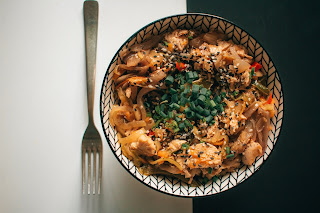NUTRITION
WHAT IS NUTRITION ?
Nutrition is defined as the processes by which an animal or plant
takes in and utilises food substances. Essential nutrients include protein,
carbohydrate, fat, vitamins, minerals and electrolytes. Normally, 85% of daily
energy use is from fat and carbohydrates and 15% from protein. In humans,
nutrition is mainly achieved through the process of putting foods into our
mouths, chewing and swallowing it. The required amounts of the essential
nutrients differ by age and the state of the body, for example: physical
activity, diseases present (e.g. prostate cancer, breast cancer or weakened
bones – known as osteoporosis), medications, pregnancy and lactation
Why is nutrition important?
Nutrition is essential for growth and development, health and wellbeing.
Eating a healthy diet contributes to preventing future illness and improving
quality and length of life. Your nutritional status is the state of your health
as determined by what you eat. There are several ways of assessing nutritional
status, including anthropometric (i.e. physical body measurement), food intake
and biochemical measurement.
ESSENTIAL NUTRITION REQUIREMENT
Nutrition can be described as the chemical components of food and can be
classified into six broad groups: carbohydrates, proteins, fats, vitamins,
minerals and water. Water is not technically a nutrient, but it is essential
for the utilisation of nutrients. Nutrients perform various functions in our
bodies, including energy provision and maintaining vital processes such as
digestion, breathing, growth and development.
ENERGY BALANCE
Your energy requirement depends on your age, size and activity level. If
your energy intake equals the amount of energy you expend, then you are in
energy balance. If your intake exceeds your expenditure, the excess energy is
converted to body fat and you gain weight. On the other hand, if your intake is
less than your expenditure, your body uses up fat stores and you lose weight.
Therefore, for weight to remain stable, the total amount of calories that are consumed
must not exceed the total that is used up through metabolic processes (e.g.
exercising, sweating, breathing). Energy intake must match energy output. The
average energy intake is about 2800 kcal/day for men and 1800 kcal/day for
women, although this varies with body size and activity level.
CARBOHYDRATES
Carbohydrates can be classified as monosaccharide (e.g. glucose, fructose,
galactose), disaccharide (e.g. sucrose, lactose, maltose) and polysaccharide
(e.g. starch, fibre). Carbohydrates must be reduced to the simplest form of
glucose (through digestion) before your body can make use of them.
Carbohydrates should make up at least 55% of your total energy intake. The
brain is a special part of the body that depends primarily on glucose for its
energy and requires about 100 g/day of glucose for fuel. In some situations,
the body can compensate for decreased levels of carbohydrates by using
alternative energy pathways such as burning fatty acids.
PROTEIN
Protein is important for the production, maintenance and repair of tissues
in the body. When energy intake is insufficient, protein intake must be raised.
This is because ingested proteins are preferentially directed towards glucose
(sugar) synthesis and oxidation. The tissues and organs in the body are made up
of protein and protein compounds. Enzymes (biological catalysts), antibodies
and hormones also consist of protein. The building blocks of protein are called
amino acids. The body can make all of the 20 amino acids except eight, which
are termed essential amino acids. These are isoleucine, leucine, lysine,
methionine, phenylalanine, threonine, tryptophan and valine. Histidine is
essential only for infants. The number and nature of amino acids present in a
particular protein determines that protein’s characteristics.
FATS
we can classified fats in two
parts,saturated fats and unsaturated fats;-
saturated fatty acids raise blood
cholesterol levels, whereas unsaturated fatty acids lower them. Saturated fats
are found in foods such as butter, meat and dairy fats. Trans fats are
artificially created during food processing. In the body, trans fats act in a
similar way to saturated fats and may raise cholesterol levels. These fats are
considered to be harmful to your health. Trans fats are found mainly in deep-fried
fast foods and processed foods made with margarine.
VITAMINS
Vitamins constitute a group of nutrients
that are needed in small quantities. Like amino and fatty acids, most vitamins
cannot be made in the body and must be obtained from dietary sources. Only
vitamin D can be manufactured by the body. Essential vitamins are grouped into
two families: water soluble and fat soluble. Water soluble vitamins can
dissolve in water (thiamine, riboflavin, niacin, vitamin C, folic acid). These
cannot be stored by the body and need to be consumed every day. Fat soluble
vitamins can dissolve in a fat medium (vitamins A, D, E, K). These are taken
into our bodies when we consume fat-containing foods. Vitamins are needed for
various reasons, including the formation of hormones and blood cells. They
generally act as coenzymes. An inadequate supply of vitamins in our diet leads
to the development of diseases.
MINERALS
Minerals are essential, acting as
cofactors of enzymes (i.e. enzymes would not exist or function without
minerals). Some of the minerals necessary for health are:
Calcium: Calcium is a very
important mineral in the diet, especially for women at menopause. The major
function of calcium is to build and help maintain strong bones. It can stop the
onset of osteoporosis and reduce bone loss and fragility. It is involved in
blood clotting. Calcium deficiency can develop when there is a lack of vitamin
D.
Iron: Iron in food exists as haem and
non-haem iron. Haem iron, found in red meat, is relatively well (20–30%)
absorbed. Non-haem iron, found mostly in cereals, pulses, certain vegetables
(e.g. spinach) and eggs, is generally less well absorbed. Non-haem iron
absorption depends on other factors in the diet. For example, vitamin C and
animal protein enhance non-haem iron absorption, while tea, coffee and phytates
inhibit it.
Zinc: Zinc represents only 0.003% of the
human body, but is essential for synthesising protein, DNA and RNA. It is
required for growth in all stages of life. Sources include meats, oysters and other
seafood, milk, and egg yolk.
WATER
RELATED BLOGS FROM 07NUTRITION:-









Comments
Post a Comment